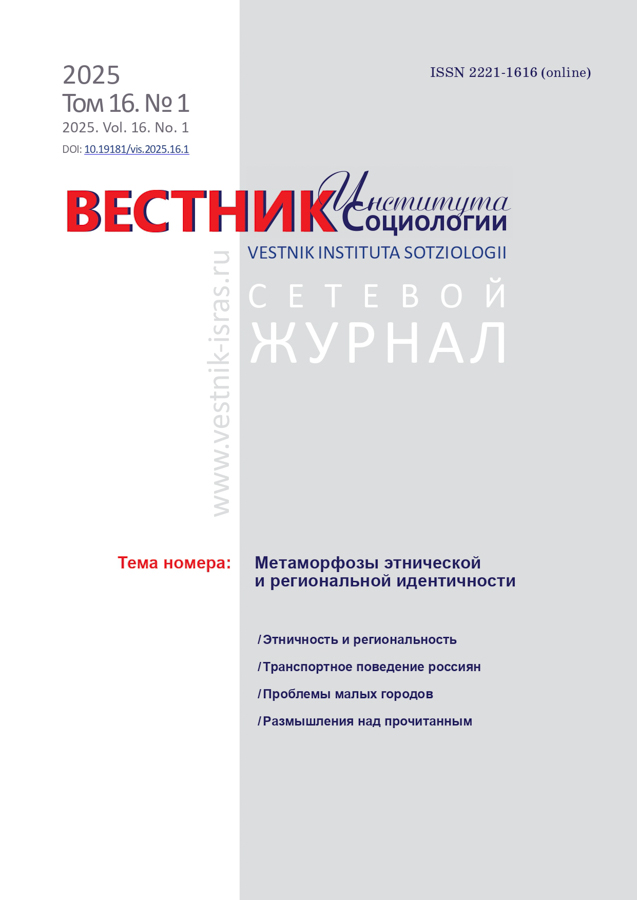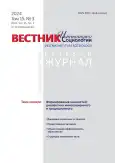Network technologies as a tool for self-presentation of small religious groups (the case of Buddhism new for Russia)
- Authors: Ostrovskaya E.A.1, Badmatsyrenov T.B.2,3,4,5
-
Affiliations:
- St. Petersburg State University
- Buryat State University named after D. Banzarov
- Center for Socio-Political Research "
- Alternative"
- Issue: Vol 15, No 3 (2024)
- Pages: 79-106
- Section: Topic of the Issue: Formation of Values: Dialectics of Innovative and Traditional
- URL: https://journal-vniispk.ru/2221-1616/article/view/270235
- DOI: https://doi.org/10.19181/vis.2024.15.3.6
- EDN: https://elibrary.ru/PKBVEW
- ID: 270235
Cite item
Full Text
Abstract
About the authors
Elena A. Ostrovskaya
St. Petersburg State University
Email: e.ostrovskaya@spbu.ru
ORCID iD: 0000-0003-0664-1514
SPIN-code: 6672-8953
Doctor of Sociological Sciences, Associate Professor, Professor of the Department of Theory and History of Sociology St. Petersburg, Russia
Timur B. Badmatsyrenov
Buryat State University named after D. Banzarov;Center for Socio-Political Research "Alternative"
Email: badmatsyrenovtb@bsu.ru
ORCID iD: 0000-0002-6363-9464
SPIN-code: 5847-4109
Doctor of Sociological Sciences, Associate Professor, Head of the Department of Political Science and Sociology, Banzarov Buryat State University; Director of the Center for Socio-Political Research Ulan-Ude, Russia
References
- Актамов И. Г. Бадмацыренов Т. Б., Цыремпилов Н. В. Российский буддизм в интернет-измерении // Власть. 2015. № 7. С. 125–130. EDN: UDRSFV.
- Гришаева Е., Шумкова В. Теории среднего уровня в исследовании религии и медиа: медиатизация, медиация и RSST // Государство, религия, церковь в России и за рубежом. 2020. № 38(2). С. 28–32. doi: 10.22394/2073-7203-2020-38-2-7-40; EDN: KGECLH.
- Островская Е. А., Бадмацыренов Т. Б. Стратегии буддийских сообществ в новых медиа // Социологические исследования. 2022. № 7. С. 109–119. doi: 10.31857/S013216250019277-7; EDN: GPPGQB.
- Anderson J. The Internet and Islam’s new interpreters // Eickleman D. F. (ed.) New media in the Muslim world: The emerging public sphere. Bloomington: Indiana University Press, 1999. 213 p.
- Buddhism, the Internet, and Digital Media The Pixel in the Lotus / Ed. by G. P. Grieve, D. Veidlinger. N. Y.: Routledge, 2014. 240 p.
- Campbell H. (ed.) Digital Judaism: Jewish Negotiations with Digital Media and Culture. N. Y.: Routledge, 2015. 222 p.
- Campbell H. Framing the Human-Technology Relationship: How Religious Digital Creatives Engage Posthuman Narratives // Social Compass. 2016. Vol. 63(3). P. 302–318. doi: 10.1177/0037768616652328.
- Campbell H. Introduction: The rise of the study of digital religion // Digital Religion. Understanding Religious Practice in New Media Worlds / Ed. by H. A. Campbell. N. Y.: Routledge, 2012. 276 p.
- Campbell H. When Religion Meets Media. L.: Routledge, 2010. 232 p.
- Campbell H., Bellar W. Digital Religion: The Basics. N. Y.: Routledge, 2022. 178 p.
- Campbell H., Tsuria R. (eds) Digital Religion: Understanding Religious Practice in Digital Media. L.: Routledge, 2022. 308 p.
- Cheong P., Huang S., Poon J. Cultivating Online and Offline Pathways to Enlightenment. Religious authority and strategic arbitration in wired Buddhist organization // Information, Communication & Society. 2011. Vol. 14(8). P. 1160–1180. doi: 10.1080/1369118X.2011.579139.
- Connely L. Virtual Buddhism: Online Communities, Sacred Place and Objects // The Changing World Religion Map: Sacred Places, Identities, Practices and Politics. N. Y.: Springer, 2015. 3926 p.
- Couldry N., Hepp A. The Mediated Construction of Reality. Cambridge, UK: Polity Press, 2017. 290 p.
- Grieve G. P. The Middle Way Method: A Buddhist-Informed Ethnography of the Virtual World of Second Life // Buddhism, the Internet, and Digital Media: the Pixel in the Lotus / Ed. by G. P. Grieve, D. Veidlinger. N. Y.: Routledge, 2015. 232 p.
- Grieve G. P. Cyber Zen: Imagining Authentic Buddhist Identity, Community, and Practices in the Virtual World of Second Life. L.: Routledge, 2016. 278 p.
- Grieve G. P., Veidlinger D. Buddhist Media Technologies // The Oxford Handbook of Contemporary Buddhism / Ed. by. M. Jerryson. N. Y.: Oxford University Press, 2016. 469 p.
- Kim M. C. Online Buddhist community: An alternative organization in the information age // Hojsgaard M., Warburg M. (eds) Religion and cyberspace. L.: Routledge, 2005. 224 p.
- Krotz F. Mediatization. A concept with which to grasp media and societal change // Lundby K. (ed.), Mediatization: Concept, changes, consequences. N. Y., NY: Peter Lang, 2009. 317 p.
- Lee J. Cultivating the Self in Cyberspace: The Use of Personal Blogs among Buddhist Priests // Journal of Media and Religion. 2009. Vol. 8(2). P. 97–114.
- Lövheim M., Axner M. Mediatized religion and public spheres: Current approaches and new questions // Granholm K., Moberg M., Sjö S. (eds) Religion, Media, and Social Change. L.: Routledge, 2015. 224 p.
- Ostrovskaya E., Badmatsyrenov T. et al. Russian-Speaking Digital Buddhism: Neither Cyber, nor Sangha // Religions. 2021. Vol. 12(6). P. 449. doi: 10.3390/rel12060449.
- Ostrowski A. American Cybersangha: Building a Community or Providing a Buddhist Bulletin Board? // Buddhism, the Internet, and Digital Media: the Pixel in the Lotus / Ed. by G. P. Grieve, D. Veidlinger. N. Y.: Routledge, 2015. 232 p.
- Prebish Ch. S. The Cybersangha: Buddhism on the Internet // Religion online: Finding Faith on the Internet / Ed. by L. L. Dawson, D. E. Cowan. N. Y., L.: Routledge, 2004. 288 p.
- Radde-Antweiler K., Zeiler X. Mediatized Religion in Asia: Studies on Digital Media and Religion, L.: Routledge, 2019. 248 p.
- Schlutter M. Buddhism in the Digital World // The Wiley Blackwell Companion to East and Inner Asian Buddhism / Ed. by M. Poceski. Wiley Blackwell, 2014. 552 p.
- Veidlinger D. Introduction // Buddhism, the Internet, and Digital Media: the Pixel in the Lotus /Edited by Gregory P. Grieve, Daniel Veidlinger. New York: Routledge. 2015. 232 p.
Supplementary files











